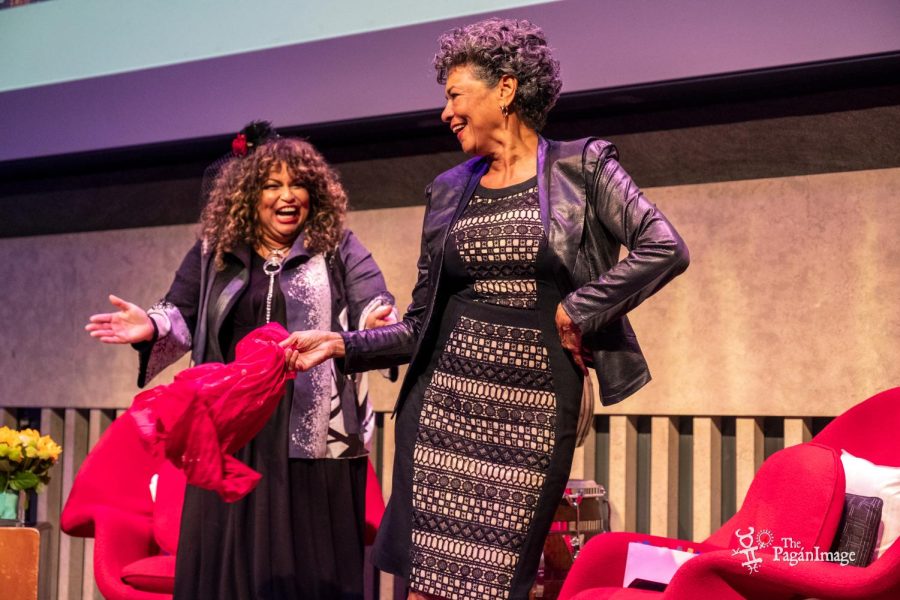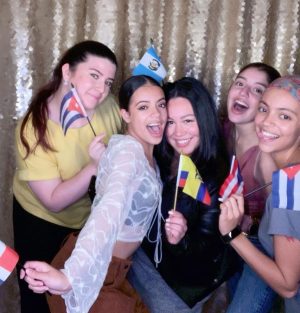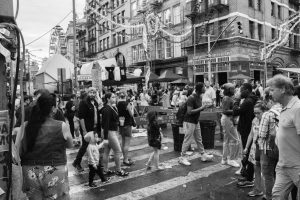Sonia Manzano: Through the Eyes of a Latine Artist
Rhina Valentin’s talk with Sonia Manzano at Lincoln Center highlights her legacy in media
EDWIN PAGAN
Rhina Valentin introduces Sonia Manzano as a “Latina living legend” at Lincoln Center’s David Rubenstein Atrium.
September 29, 2022
For me, National Hispanic Heritage Month is every day. It is not something that comes and goes in the fall that disappears into the abyss of nonexistence once Oct. 15 hits. It is an immovable cloak I proudly wear that manifests itself in my lawless hair, my warm-colored skin and the way that I speak.
This year, however, I found myself wanting to become even more connected to my history and to learn the ways in which people in my community take up space in the arts — and there is no better month to do so.
With upcoming events on campus and around the city organized to celebrate those of Hispanic and Latine heritage — the latter being a gender-neutral term intended to encompass the identities of all members of the community — I made it my goal to attend at least one to learn about what it means to be a Latine person creating in the artistic realm.
A Block Party for the Ages
On Sept. 21, I went to what can only be described as an indoor block party hosted by television host and spokesperson Rhina Valentin, with special guest star, Emmy Award-winning actress and author Sonia Manzano. The event took place at Lincoln Center’s David Rubenstein Atrium on 62nd Street from 7-9 p.m.
When I walked through the doors of the main entrance, I was greeted by a man named Tomás, who identified himself as a “piragüero,” which is a person who serves the traditional Puerto Rican dessert that comes in the shape of a cone and is a frozen treat usually sold during summertime. He stood behind his vibrant pushcart making and handing out free shaved ice concoctions doused in fruit-flavored syrups like piña colada and tamarind.
As I talked with Tomás, he told me about the different names that Latin American countries have for this delicacy. In Puerto Rico they call them “piraguas,” whereas in the Dominican Republic they are known as “frio-frio”; in Mexico they are called “raspados”; and Cubans refer to them as “granizados.”
“You wondered what you were going to contribute to a society that was blind to you. They didn’t see you.” Sonia Manzano, Emmy Award-winning actress and author
As I drank my cherry-flavored piragua, the sound of drums coming from the back of the room caught my ear and my body’s attention. Musical organization “BombaYo,” headed by its director Jose “Mr. Drum” Ortiz, was playing and singing the melodies of the Afro Puerto Rican style “bomba” — a dance and music genre that emerged from the culture of enslaved West Africans on the Caribbean islands.
While Ortiz and a few others played the “barriles” (drums) and sang, other members of their group carried out the harmonies and danced around the room while wearing traditional folk dresses. A small crowd even gathered around a table to watch others as they played a round of the game Dominoes, or as Latines pronounce it: dominó.
The stage was set, the ambiance was palpitating with Latine culture and art, and Puerto Rican painter Victor Ramos — professionally known as “Sloan” — stood nearby placing the vibrant life inside the room onto a white canvas.
Sonia Manzano’s Life and Legacy
After our cones were drained of flavor, and the musicians and dancers settled into a quieter symphony, Valentin danced her way onto the stage and beautifully transitioned into a poem she wrote about Manzano’s accomplishments in the television industry. She introduced the actress as a “Latina living legend,” and petitioned the crowd to “scream really loud” as Manzano made her way up the steps.
Manzano spent 44 years of her life on the kids and family program “Sesame Street,” playing the character Maria and writing for the show. She has since authored nine books, all of which are scholastic and aimed toward young audiences. She also created the show “Alma’s Way,” which has recently been renewed for a second season on PBS Kids.
Throughout the conversation, Manzano placed great emphasis on the significance of children and the youth when it comes to creative expression and decision-making. The majority of the storylines she has written have been inspired by real experiences she had throughout her childhood living in the Bronx.
She said that she hopes her legacy will be one that influences other Latine and Hispanic artists to create something they perhaps never had while growing up. She wishes for young children of color to feel seen and represented in the media they consume and feel welcomed into artistic spaces that have seldom allowed room for them.
She described the young stage of people’s lives as being the moment when “it all happens” and explained that finding beauty in terrible things that occur during that time can be something incredibly inspiring when making art. She added that she survived her childhood by “finding the banal and exalting it” through her writing.
Navigating the politics of a television production as a Latina proved to be difficult for Manzano. Her identity impacted her desire to pursue her career, and she even stated, “You wondered what you were going to contribute to a society that was blind to you. They didn’t see you.”
The actress routinely worried about how she looked and spoke and was careful about the cultural ideas she would bring forth out of fear they would be rejected. She talked about how her habit of speaking “Spanglish” on the program was met with remarks on the improperness of the hybrid language, even though they always urged her to be herself.
Manzano spoke on the importance of staying true to her passions regardless of the way she was ever being treated. In comparison to her white counterparts, there were times when she felt she might’ve deserved more than what she was being offered, but this never deterred her need to produce quality content despite her circumstances. She said, “If the book you’re writing isn’t good, it’s not good, or it’s gonna be good no matter where they put you up.” Stay focused on the task at hand, because regardless of how you’re rewarded, your work will always speak for itself.
One of Manzano’s inspirations was the 1961 movie “West Side Story” starring Puerto Rican actress and film icon Rita Moreno — who presented her with the Lifetime Achievement Emmy award in 2016, alongside the co-writer of the theme song for “Alma’s Way,” Lin-Manuel Miranda. On “West Side Story,” she said that seeing a neighborhood that she was so familiar with be illustrated on the big screen was incredibly powerful.
“The first time I saw my crummy neighborhood look so beautiful, it’s like an impressionist painting,” she said.
Manzano chose to retire from “Sesame Street” in 2015 in order to leave room for the newer generations that were being brought into that creative space. She said that she hopes her legacy will be one that influences other Latine and Hispanic artists to create something they perhaps never had while growing up. She wishes for young children of color to feel seen and represented in the media they consume and feel welcomed into artistic spaces that have seldom allowed room for them.
The night ended with more music and dance, and Valentin’s musically-inclined daughter walking onto the stage and gifting some radiating flowers to Manzano. This special moment showed the audience the importance of “giving someone their flowers” while they are still around to feel the impact their life has had on those who are coming after.
Strength of Latine Community Lives On
The experience was an enlightening one that affirmed the strength of the Latine community during a time of such arduous struggle with the destruction of Hurricane Fiona blazing through the Caribbean. The Senior Director for Artistic Programming at Lincoln Center, Jordana Leigh, briefly spoke about the East Bronx community and boxing center, El Maestro, that has been working towards helping the people of Puerto Rico. El Maestro continues to accept donations to support those affected by Hurricane Fiona on the island.













